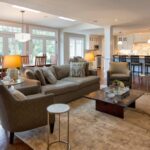
Opening up an older home takes advantage of natural light and blends all the aspects of 21st century daily life into an elegant space.
An open concept for your living space develops in your imagination, only with planning and skill does it translate into an open floor plan. Modern media make it seem as though all that stands between you and the perfect Madison WI home is a wall or two. Knock down the walls and harmonious family life follows. Don’t get carried away.
It’s true, knocking down a wall drastically changes the interior of your home. Kitchens, dining rooms and living areas quickly become one big room. A wide open floor plan creates a showroom. Big rooms need big furnishing and open your entire lifestyle to all who enter. There’s no nook or cranny to hide disorder, clutter or mess.
The bottom line: a wide open plan doesn’t fit every structure and that means both building and lifestyle. Professional interior designers know the key is for homeowners to control their space, not let it control them.
The Open Floor Plan Isn’t New
The idea of an open interior floor plan didn’t start with the first remodeling show on HGTV. It’s been in the architect’s playbook for decades. It has however been the main focus of many remodeling projects in recent years. The concept of opening up your home is based on the idea of a communal living space – a “great room.” Also called the “family room” linking the kitchen, dining area and living room keeps everyone’s activities connected. In modern families, daily life revolves around the kitchen so making it easily accessible to the rest of the house makes sense, right? Clear views from the kitchen to group activities makes sense, too – especially for entertaining friends and relatives.
By definition, a floor plan that’s “open” connects two or more rooms without defining walls or obstructions. It might be kitchen and dining, kitchen and living or living and dining spaces. You provide the final definition and how it fits your home.
The most common creations to open sightlines and benefit traffic patterns are:
- Kitchen to dining room – making passage of meals and people from the kitchen to the eating area simpler and more efficient. The No. feature is the kitchen island. A multi-functional island works as a meal preparation spot, informal dining area, gathering place and in a pinch, a desk for homework.
- Dining room to living room – informal dining has taken over in modern families. Fast-paced lifestyles don’t fit the mold of sitting down together for meals as often as they once did.
- All-in, All Open – if your home’s architecture and your lifestyle dictate, one very large open space is possible to connect all three aspects of daily life without many physical barriers.
Build Upon An Open Concept
Recreating your home with an open plan may or may not be possible. That wall you want to knock down may be holding up the second floor or the attic. Only a skilled professional knows for sure. Moving from an open concept floor plan on paper to reality has its ups and downs.
As you build up on your concept, consider the advantages:
- Traffic flow – people easily move through the space without opening doors or navigating around walls.
- Personal interaction – it’s easy to socialize and to communicate from one end of the house to another without walls in the way.
- Family interaction – you can watch the kids while you cook (or the game). While chores in the kitchen get done you’re still involved with what’s happening.
- Advantage of natural light – open spaces share light and knocking down walls brings natural light into rooms that didn’t have windows.
- Decorating options – spaces become multi-functional and interactive opening possibilities to many furnishing options.
- Improves real estate value – because the open concept design is extremely popular and “trendy” a project to open your floor plan provides a reliable return on the investment.
Wide Open Spaces Aren’t For Everyone
Before you make a final commitment, consider there are disadvantages, too:
- Heating and cooling – it is less efficient to heat or cool a large open space. Trendy great rooms with vaulted ceilings are not energy efficient. Big rooms with large windows are more difficult to maintain at even temperatures. Your remodel will almost always require additional venting, etc.
- Noise – there is very little you can do to control sound in a great room. No doors to close when you want to get away from the kids or the TV. The noise associated with the kitchen is also a consideration that seldom worries people until they knock out a wall or two.
- Demands to be ‘tidy’ – in wide open spaces there’s no place to conceal clutter. Opening up the floor plan puts a premium on keeping everything from furnishings to utensils to a minimum.
- No privacy – great for social activities, open spaces are not good when you want to be alone to read, study or relax. Unless you’re OK with escaping to another part of the house for these activities, a completely open plan may not be what you need.
In the spirit of controlling your space, consider ways to build around the advantages you’re looking for and minimizing the disadvantages. Even opening up one or two rooms is a big decision. You want to create a space that’s perfect for your family, right?
Let A Designer Create Your Open Floor Plan
As you walk through your home or sit and ponder “what if,” ways an open concept design can become a reality. Understand, there’s a lot more than magazines, videos and TV productions lead you to believe. A major remodel adds glamor, sophistication and elegance to your older home. But it doesn’t come without a significant commitment – a commitment to more than money. Opening up the floor plan of your home, whether for two rooms or the entire first floor, is a major commitment in time. It’s disruptive and often frustrating.
While you’re gathering ideas and building on your vision include the benefits of a professional interior design organization on your “must have” list. Why? Professionals offer:
- Years of experience
- Skill and attention to details
- They’ve dealt with every situation – includes those you cannot imagine
- They save you time – and in remodeling, time really is money
- Expertise from planning to daily on-site supervision
- Resources you cannot access
In the end, the most important element that comes from working with well-versed interior designers is peace of mind. You don’t have to worry about all the little things – because they already are!
When you’re ready to move beyond a concept call or email us. We’ll show you how to bring a vision to life. We welcome an opportunity to share our experiences and answer questions. Review our portfolio on line and see how we bring an open floor plan to life in Madison WI homes.
https://dcinteriorsllc.com/translating-open-concept-create-open-floor-plan/
No comments:
Post a Comment